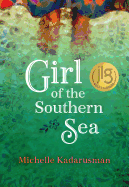
When Nia was 9, her mother died giving birth to her brother, Rudi. Ever since, all the money her father makes from their fried banana cart goes to his alcoholic beverage of choice, arak. Now 14, Nia survives a deadly minibus crash in her home city of Jakarta, Indonesia, and rumors begin to swirl about her "good-luck magic." Good luck brings in business, and Nia is desperate to raise money for high school fees. A suspiciously eager local merchant offers to help her promote this idea, and, even though she knows it's only superstition, she is easily swayed. As Nia's father recovers from his own accident--an altercation with the police because he refused to pay bribe money--Nia begins charging double the usual price for the fried bananas, socking away the proceeds to pay household expenses and, she hopes, school fees. The plan quickly begins to fall apart, though, and Nia discovers that, as a wise old woman named Ibu Jaga says, "Lies and superstitions cause pain."
With all the stress, Nia finds that the only way to "quiet [her] thoughts is to write." She soothes Rudi with her own made-up versions of the traditional Javanese folktale about the queen of the Southern Sea. In Nia's stories, the banished queen finds ways to overcome her hardships, rather than succumbing to the evil curse cast on her by a witch. But is Nia capable of rewriting her own story?
In Girl of the Southern Sea, Michelle Kadarusman (The Theory of Hummingbirds) delves gracefully into weighty subjects like poverty, slum living, and forced marriages, as well as limited access to education, healthcare and opportunities for the future, especially for girls. Upbeat, optimistic Nia is a very relatable protagonist, even for those who can't fathom her day-to-day existence. --Emilie Coulter, freelance writer and editor

